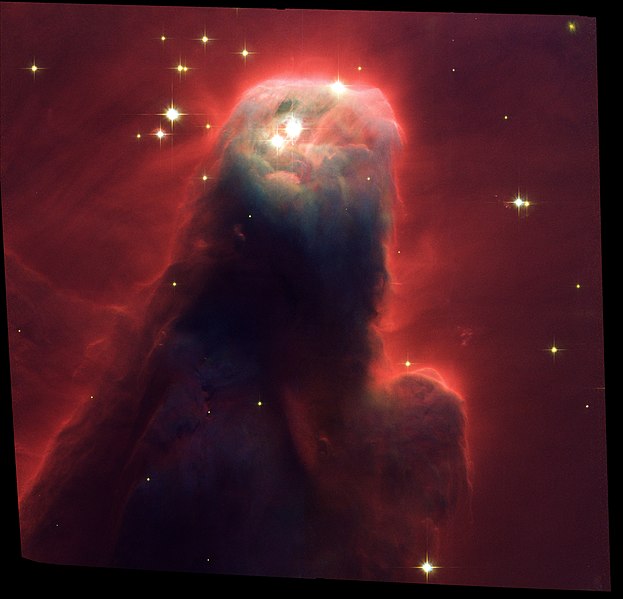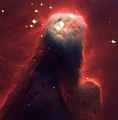Tập tin:Cone Nebula (NGC 2264) Star-Forming Pillar of Gas and Dust.jpg

Kích thước hình xem trước: 623×599 điểm ảnh. Độ phân giải khác: 250×240 điểm ảnh | 499×480 điểm ảnh | 799×768 điểm ảnh | 1.065×1.024 điểm ảnh | 2.130×2.048 điểm ảnh | 4.427×4.257 điểm ảnh.
Tập tin gốc (4.427×4.257 điểm ảnh, kích thước tập tin: 7,11 MB, kiểu MIME: image/jpeg)
Lịch sử tập tin
Nhấn vào ngày/giờ để xem nội dung tập tin tại thời điểm đó.
| Ngày/giờ | Hình xem trước | Kích cỡ | Thành viên | Miêu tả | |
|---|---|---|---|---|---|
| hiện tại | 19:17, ngày 3 tháng 1 năm 2014 |  | 4.427×4.257 (7,11 MB) | HombreDHojalata | Reverted |
| 11:42, ngày 3 tháng 1 năm 2014 |  | 3.690×3.743 (10,33 MB) | Elisardojm | Reverted to version as of 20:43, 1 March 2007 High file and crop ok | |
| 11:09, ngày 13 tháng 8 năm 2012 |  | 4.427×4.257 (7,11 MB) | Fabian RRRR | * source: http://www.spacetelescope.org/images/heic0206f/ * higher resolution, * better suited copyright | |
| 20:43, ngày 1 tháng 3 năm 2007 |  | 3.690×3.743 (10,33 MB) | Bricktop | high quality jpg, converted from tiff | |
| 22:02, ngày 28 tháng 2 năm 2007 |  | 3.690×3.743 (987 kB) | Wilfredor | ;The Cone Nebula http://hubblesite.org/gallery/album/nebula_collection/pr2002011b/ {{PD-Hubble}} Category:Helix Nebula |
Trang sử dụng tập tin
Có 1 trang tại Wikipedia tiếng Việt có liên kết đến tập tin (không hiển thị trang ở các dự án khác):
Sử dụng tập tin toàn cục
Những wiki sau đang sử dụng tập tin này:
- Trang sử dụng tại ar.wikipedia.org
- Trang sử dụng tại ast.wikipedia.org
- Trang sử dụng tại ca.wikipedia.org
- Trang sử dụng tại co.wikipedia.org
- Trang sử dụng tại crh.wikipedia.org
- Trang sử dụng tại de.wikipedia.org
- Trang sử dụng tại en.wikipedia.org
- Cone Nebula
- Perceptions of religious imagery in natural phenomena
- User:Devinma
- User:Seresin/Pictures
- Wikipedia:Featured pictures thumbs/11
- Wikipedia:Featured picture candidates/August-2008
- User:Ceranthor/FPC
- Wikipedia:Featured picture candidates/Cone Nebula
- Wikipedia:Wikipedia Signpost/2008-09-08/Features and admins
- Wikipedia:Wikipedia Signpost/2008-09-08/SPV
- User talk:Ceranthor/Archive 7
- Wikipedia:Featured pictures/Space/Looking out
- Wikipedia:Picture of the day/March 2009
- Template:POTD/2009-03-27
- Template talk:Track listing/Archive 3
- Wikipedia:Wikipedia Signpost/Single/2008-09-08
- Trang sử dụng tại en.wikiversity.org
- Trang sử dụng tại en.wiktionary.org
- Trang sử dụng tại eo.wikipedia.org
- Trang sử dụng tại es.wikipedia.org
- Trang sử dụng tại eu.wikipedia.org
- Trang sử dụng tại ext.wikipedia.org
- Trang sử dụng tại fa.wikipedia.org
- Trang sử dụng tại fi.wikipedia.org
- Trang sử dụng tại fr.wikipedia.org
- Trang sử dụng tại fy.wikipedia.org
- Trang sử dụng tại gl.wikipedia.org
- Trang sử dụng tại he.wikipedia.org
- Trang sử dụng tại hu.wikipedia.org
Xem thêm các trang toàn cục sử dụng tập tin này.
Đặc tính hình
🔥 Top keywords: Đài Truyền hình Kỹ thuật số VTCTrang ChínhGiỗ Tổ Hùng VươngTrương Mỹ LanĐặc biệt:Tìm kiếmHùng VươngVương Đình HuệUEFA Champions LeagueKuwaitChiến dịch Điện Biên PhủFacebookĐài Truyền hình Việt NamTrần Cẩm TúĐội tuyển bóng đá quốc gia KuwaitGoogle DịchViệt NamCúp bóng đá U-23 châu ÁCúp bóng đá U-23 châu Á 2024Real Madrid CFBảng xếp hạng bóng đá nam FIFACleopatra VIITô LâmTim CookNguyễn Phú TrọngHồ Chí MinhHai Bà TrưngManchester City F.C.VnExpressChủ tịch nước Cộng hòa xã hội chủ nghĩa Việt NamNguyễn Ngọc ThắngĐền HùngCúp bóng đá trong nhà châu Á 2024Võ Văn ThưởngOne PieceLịch sử Việt NamCuộc đua xe đạp toàn quốc tranh Cúp truyền hình Thành phố Hồ Chí Minh 2024Phạm Minh ChínhTikTokĐinh Tiên Hoàng
